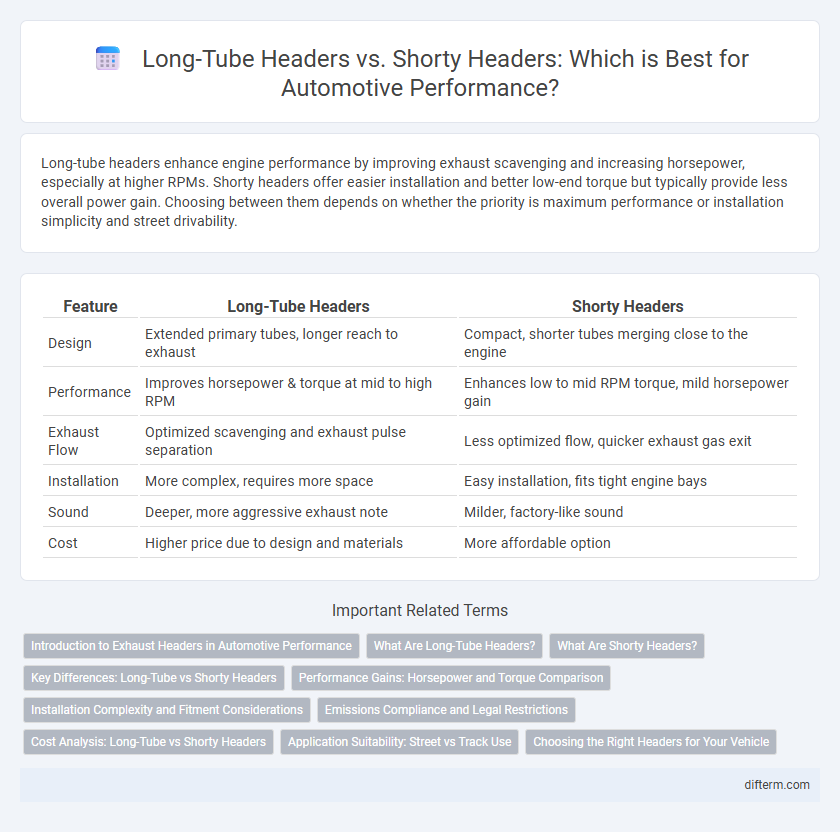Long-tube headers enhance engine performance by improving exhaust scavenging and increasing horsepower, especially at higher RPMs. Shorty headers offer easier installation and better low-end torque but typically provide less overall power gain. Choosing between them depends on whether the priority is maximum performance or installation simplicity and street drivability.
Table of Comparison
| Feature | Long-Tube Headers | Shorty Headers |
|---|---|---|
| Design | Extended primary tubes, longer reach to exhaust | Compact, shorter tubes merging close to the engine |
| Performance | Improves horsepower & torque at mid to high RPM | Enhances low to mid RPM torque, mild horsepower gain |
| Exhaust Flow | Optimized scavenging and exhaust pulse separation | Less optimized flow, quicker exhaust gas exit |
| Installation | More complex, requires more space | Easy installation, fits tight engine bays |
| Sound | Deeper, more aggressive exhaust note | Milder, factory-like sound |
| Cost | Higher price due to design and materials | More affordable option |
Introduction to Exhaust Headers in Automotive Performance
Long-tube headers provide enhanced exhaust flow by increasing the length of the primary tubes, which improves scavenging and boosts horsepower and torque, especially at higher RPMs. Shorty headers offer a more compact design that fits easily into tight engine bays, delivering quicker throttle response and improved low-end torque but typically less overall performance gain compared to long-tube headers. Both types of headers replace restrictive factory manifolds, reducing backpressure and improving engine efficiency for better automotive performance.
What Are Long-Tube Headers?
Long-tube headers are performance exhaust components designed with extended primary tubes that merge further downstream compared to shorty headers, improving exhaust gas flow and engine efficiency. By increasing scavenging effects and reducing backpressure, long-tube headers enhance horsepower and torque, particularly in high-performance and racing applications. Their design typically requires more installation space and modifications but delivers superior gains over shorty headers in power and sound quality.
What Are Shorty Headers?
Shorty headers are exhaust components designed to replace factory manifolds, featuring shorter primary tubes that bolt directly to the engine's exhaust ports. They improve exhaust flow and horsepower compared to stock manifolds by reducing backpressure while maintaining a compact design ideal for tight engine bays. Shorty headers provide a cost-effective performance upgrade with easier installation and compatibility with emissions controls.
Key Differences: Long-Tube vs Shorty Headers
Long-tube headers feature extended primary tubes that improve exhaust gas scavenging, increasing horsepower and torque, especially at higher RPMs. Shorty headers have shorter primary tubes designed for easier installation and better low-end torque, making them suitable for daily driving and emissions compliance. The choice between long-tube and shorty headers depends on desired performance characteristics and vehicle compatibility.
Performance Gains: Horsepower and Torque Comparison
Long-tube headers typically offer greater performance gains over shorty headers by improving exhaust scavenging and increasing horsepower and torque across the RPM range. Shorty headers provide moderate improvements but are often favored for easier installation and better low-end torque. Vehicle-specific tuning and application significantly influence the actual performance differences between the two header types.
Installation Complexity and Fitment Considerations
Long-tube headers require more complex installation due to their length and routing, often necessitating modification of existing components and providing a snug fit in engine bays with limited space. Shorty headers offer easier installation with a more compact design that aligns closely with factory manifolds, reducing interference with other engine parts or accessories. Fitment considerations for long-tube headers are critical in vehicles with tight engine compartments, while shorty headers are preferred for maintaining factory clearance and minimizing installation time.
Emissions Compliance and Legal Restrictions
Long-tube headers offer improved exhaust flow and performance but may struggle to meet stringent emissions compliance standards due to higher hydrocarbon and nitrogen oxide outputs. Shorty headers are more likely to pass legal restrictions as they maintain closer proximity to OEM catalytic converters and oxygen sensors, ensuring more effective emissions control. Selecting the appropriate header type requires balancing performance gains with adherence to EPA regulations and state-specific vehicle emission laws.
Cost Analysis: Long-Tube vs Shorty Headers
Long-tube headers generally cost more due to their complex design and higher-grade materials, which enhance exhaust flow and engine performance. Shorty headers offer a budget-friendly alternative with simpler installation but may sacrifice some power gains and exhaust scavenging efficiency. Considering overall value, long-tube headers provide better long-term performance benefits despite the higher initial investment compared to shorty headers.
Application Suitability: Street vs Track Use
Long-tube headers enhance exhaust scavenging and improve high-RPM power, making them ideal for track use and aggressive driving conditions where maximum performance is critical. Shorty headers offer a more compact design, providing better torque at lower RPMs and improved drivability, which suits street vehicles focused on daily reliability and emission compliance. Choosing between long-tube and shorty headers depends on whether the primary goal is track performance or street-friendly operation.
Choosing the Right Headers for Your Vehicle
Long-tube headers improve exhaust flow by increasing scavenging, delivering better horsepower and torque gains for high-performance engines, especially in muscle cars and trucks. Shorty headers offer a more compact fit, easier installation, and cost-effective performance boosts, ideal for street vehicles and daily drivers seeking moderate power improvements. Selecting the right headers depends on vehicle type, engine configuration, and desired performance outcomes, balancing space constraints with horsepower goals.
long-tube headers vs shorty headers Infographic

 difterm.com
difterm.com